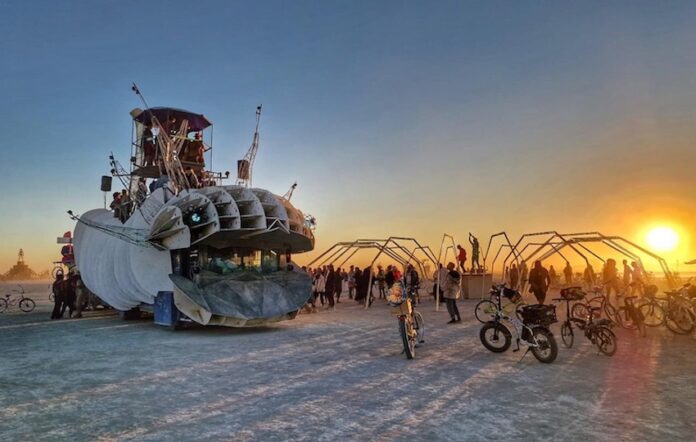In the sweltering Nevada desert, amid a sprawling temporary city of more than 75,000 people, the Burning Man festival has once again transformed a beautiful but inhospitable landscape into a pulsating arena of creativity, community, and radical self-expression. And increasingly, it is Mexican artists who are at the heart of this global gathering — bringing monumental visions that merge tradition, technology and deep cultural storytelling.
In 2025, that growing presence reached a new peak with the unveiling of “Kauyumari Ceremonial Center” an enormous deer sculpture created by 50 Mexican artists, including 18 Indigenous Wixárika artists and local artists from Torreón, Coahuila. This years’ offering has been designed by Mexican multidisciplinary artist Leyla Brashka under the auspices of the Mexico-based Burning Man collective ¡AXOLOTL!. Rising 6.5 meters high and equally wide, Kauyumari is beyond an artwork, a ceremonial space for peyote ceremonies to be held which will be donated to the Wixárika culture embodying Indigenous symbolism and contemporary festival culture in a single, awe-inspiring installation.

“Kauyumari is not only a sculpture,” said Brigham Golden co-founder of ¡AXOLOTL! “It’s a vessel for ancient wisdom, a meeting place between the ritual practices of Mexico’s Indigenous communities and the transformative spirit of Burning Man.”
A city built on ideals
Burning Man is often misunderstood as simply an art festival or music gathering. In reality, it’s a self-built city that comes alive for just one week each year in Nevada’s Black Rock Desert. Founded in 1986 as a small beach gathering, it has grown into one of the world’s most celebrated creative events. Its core is guided by 10 principles — from radical inclusion and self-reliance, to communal effort, gifting and leaving no trace.
During that week, participants construct Black Rock City, complete with restaurants, clinics, workshops, airstrips, even a post office all operating by volunteers in a non commodified evening where everything is shared — or “gifted”. But perhaps its most defining feature is art: massive, interactive works designed to be touched, climbed, burned or experienced collectively.
It is here that Mexican collectives like La Calaca, Mayan Warrior, Maxa and AXOLOTL have found their voice, introducing installations that bridge heritage with innovation.
Mexico’s artistic presence
The Mexican influence at Burning Man has been steadily growing for a decade. The Mayan Warrior art car — an electronic music powerhouse and mobile light installation — helped establish Mexico’s reputation as a creative force on the playa. La Calaca and Maxa brought monumental fire-driven and sculptural artworks.
AXOLOTL, named after the storied Mexican amphibian often known as the “walking fish,” has become one of Burning Man’s most recognizable mobile installations. Its vibrant art car, shaped like a massive glowing axolotl, has embodied the whimsical, surreal qualities that define desert nights.
But with kauyumari, the collective has shifted from whimsical to spiritual, offering what participants describe as one of the most profound creations of Burning Man 2025.
The Deer Spirit
For the Wixárika people, who live primarily in the Sierra Madre Occidental of western Mexico, the deer is not just a symbol — it is sacred. Known as maxa, the deer occupies a central role in ceremonial life, representing a messenger between humans and the divine. It is also tied to the peyote cactus, a plant regarded as a portal to spiritual knowledge.
Kauyumari channels this spiritual role. The immense deer, painstakingly assembled and hand-embellished by artisans over the course of a year, contains an inner chamber where festival participants can gather, reflect or even perform ceremonies in conversation with the art. Decorated in the Wixárika tradition of intricate bead and yarn patterns, the sculpture is bathed at night in luminous light, transforming into a shrine within the desert expanse.
“This is more than an artwork to admire,” said Leyla Brashka who spearheaded the design. “It is a prayer and a teaching, expressed in monumental form. By bringing kauyumari to Burning Man, we are inviting thousands to encounter the living traditions of Mexico’s Indigenous communities.”
In a festival where giant robots, interactive LED temples and fire-shooting dragons roam the dunes, kauyumari offers something different. Its very presence highlights how art at Burning Man has evolved: no longer just a playground of radical experimentation, but also a platform where ancient traditions find fresh expression.
Scholars of contemporary art point to Burning Man as one of the largest living museums in the world — though without walls or tickets. And in that open-air, ephemeral museum, Mexico’s contributions have become among the most celebrated.
“Artists from Mexico have reshaped the visual language of Burning Man. What makes works like kauyumari powerful is how they bring Indigenous aesthetics into conversation with global audiences in ways that are profoundly respectful and deeply moving.
After the burn
Although each Burning Man installation by tradition is temporary — many destroyed, burned or dismantled at the festival’s end — collectives increasingly work to preserve their most impactful works. Discussions are already underway to bring kauyumari back to Mexico after the festival, where it could continue its role as a ceremonial and artistic gathering space.
In that sense, the work embodies another principle of Burning Man: continuity. What is born in Black Rock City does not end when the desert empties but instead reverberates outward, reshaping culture across borders.
Looking ahead
With collectives like AXOLOTL and visionaries like Leyla collaborating with Indigenous communities, Mexico’s presence at Burning Man shows no signs of slowing. Even as the festival continues to draw participants from more than 70 countries, Mexican artists are establishing themselves as leaders at the intersection of spectacle, heritage and technology.
As the glowing deer of kauyumari casts its light across Black Rock City this year, it reminds participants that art is not only something to marvel at but also to learn from. In the desert, the future of festival art is converging with the wisdom of ancestral traditions.
And at the vanguard of that convergence are the Mexican artists reimagining what Burning Man — and monumental art itself — can be.
Mexico News Daily
